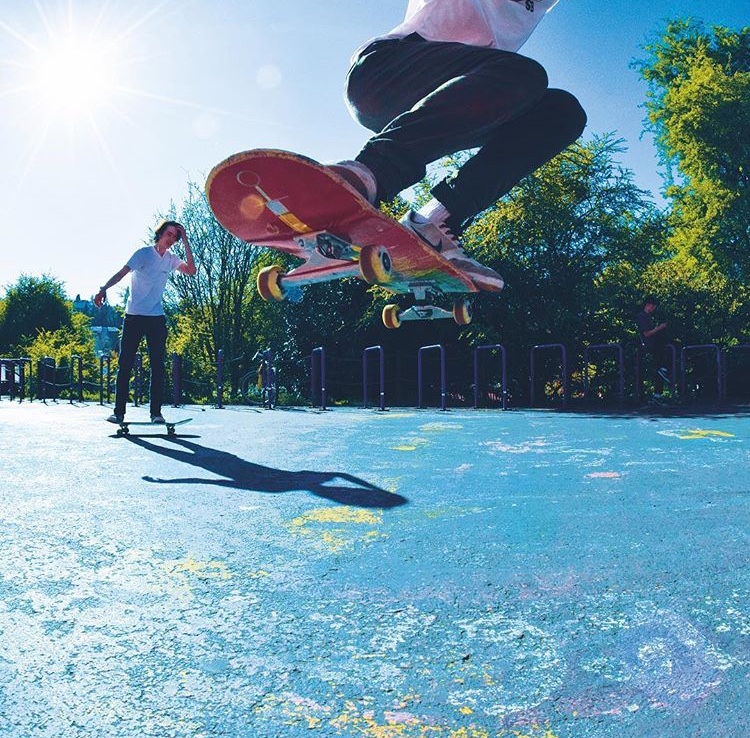Skate culture at LHS declining
Skateboarders outside Lincoln in 2016.
Skateboarding is a mysterious sport. It was created in California in the 1940s by surfers who wanted something to do when surfing conditions were not ideal.
Some people find it fun to watch the intricate maneuvers skaters can do with their feet and boards. Others believe skateboarders destroy property. Although it is controversial, a study in 2010 by the New York Times sites that the skate industry is worth $5 billion a year.
The white and red ledge outside of the front doors of Lincoln has been used by skaters from all over the city. The school’s campus and skaters have gained attention after featuring in many skateboarding videos including Thrasher Magazine’s “Portland Public Skating” video on Youtube, poking fun at the abbreviation PPS, Portland Public Schools.
Thrasher Magazine is a highly regarded publication in the skateboarding industry. The logo is all over hoodies, t-shirts, and hats around Lincoln. Vans is also a popular shoe company, making skateboarding-designed shoes.
In the skateboarding world there are three main types of skateboarding: freestyle, transition, and street. Freestyle is when the skateboarder uses the sides or bottom of the skateboard to do the tricks, while street skating is when you only touch the top, and you do it on a rail, stair, or anything along the street. Transition or “tranny” skating evolved from skating in empty swimming pools, and now has evolved into skating on 200 foot ramps.
Longboarding or “street surfing,” another branch of skateboarding, became popular in Hawaii. These skateboards are longer, hence the name “longboard” and generally have bigger, thicker wheels, and are used more for long-distance travel rather than tricks.
“You can’t really do many tricks on a longboard, as they’re more made for cruising, but I’ve tried nonetheless,” says Kylie Newland, a sophomore.
The closest public skate park to Lincoln is Burnside Skatepark, which is a 10 minute drive depending on traffic, or a 35 minute walk. The next closest is Gabriel Skatepark, which is a 15 minute drive.
Lincoln used to have a large skate scene. “There isn’t much of a skate scene at Lincoln,” says Liem McKenzie, a sophomore, “at least not like their used to be.”
It is also not very diverse. “There aren’t many girl skaters that come around very often,” says McKenzie, “mostly boys.”
“Personally,” Newland said, “I keep to myself in the skating community. Only a few of my friends skate, and I don’t really know anyone else besides them. It does make me annoyed, and I have been subject to a few sexist remarks while boarding in the past. I’ve heard remarks like ‘Girls can’t skate’ and stuff like that, and that really bothers me.”
According to Stan Caples, one of Lincoln’s campus security guards, “Skateboarding is not tolerated during school hours. Anyone who does is trespassing,” Caples says. “During school is one thing but after 4:00, nobody is here to man the school grounds.” Although the outside campus is open to the public, there is no skateboarding on school grounds during school hours.
Above each entrance to Lincoln, there are signs that read “Skateboarding Unsafe and Prohibited”. Although the signs are there and the rules are technically implied all day, people still choose to skate there. Mckenzie says, “We are just trying to have fun.”


Charlie • Mar 11, 2022 at 10:50 am
I enjoy skateboarding in my free time and also my pet dog loves riding a deck. So I got him a skateboard after reading about skateboards for dogs here https://skateboardslife.com/best-skateboards-for-dogs/
Mark harry • Nov 20, 2021 at 3:32 am
Skateboarding is a loveable sport. I just started it. This post help me to learn more. Thanks https://skatetownguide.com/best-skateboard-for-english-bulldog/
Mikii • Jul 18, 2020 at 12:14 am
Thanks for sharing this information. like the most longboarding which is also known as street surfing. I like traditional longboards as well as electric longboards. I follow BoardsRider to get useful tips and tricks on that
Dorothy L. Rogers • Jul 13, 2019 at 10:20 am
Really impressive article you have shared! It’s really a mysterious sport. Skateboarding is a love. this article is motivate to skating on street truly. I have tried to find some skateboard, which is electric as well as cheap. At least, I have found a nice article. Here it’s: https://skatingpoint.com/electric-skateboard-under-500/
Hope like me, it will help you as this above article.
Dorothy L. Rogers • May 10, 2019 at 11:05 am
You have done excellent in this article. The accurate history of skateboard I have ever found. Thank you, author!
I have also a skating related blog, https://skatingpoint.com. You guys look over in this.
Michael Brunce • Jan 10, 2019 at 11:04 pm
Great article! I am a great lover of skateboards. We should be let to skate all day, anywhere. Its a good sport and it helps you keep sane. I collect a lot of skateboards and I got one recently from justperi.com
You should definitely check them out.They are supercool skateboards. https://justperidrive.com/collections/electric-skate-boards
shaqa khan • May 2, 2022 at 8:59 pm
yes also found on skateboardwarriors.com
shaqa khan • May 2, 2022 at 9:00 pm
https://skateboardwarriors.com/